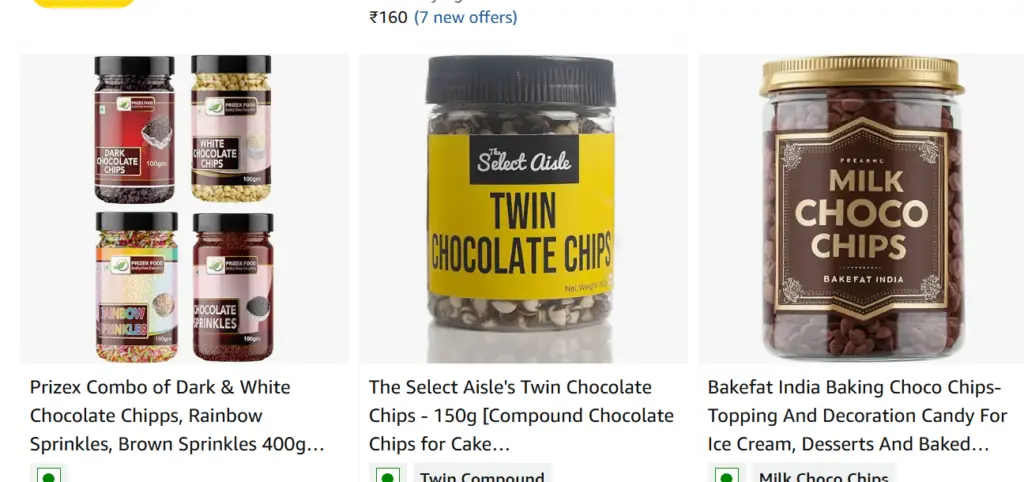
When shoppers browse Amazon, the product title is one of the first things they notice—right alongside the main image, price, and customer reviews. It’s your product’s headline, the first impression that determines whether someone clicks or scrolls past.
Table of Contents
ToggleA well-crafted title doesn’t just describe your product; it sells it. By strategically including relevant keywords and highlighting key benefits, you increase your chances of showing up in Amazon’s search results page(SERP) and attracting the right customers.
Take a look at the screenshots of the Amazon search result for chocolate chips below. Aside from the product images and any text on the packaging, the titles are the only written information shoppers see at a glance. These few words play a crucial role in helping customers decide if the product matches what they’re looking for. Optimizing your title can make the difference between getting clicks—or getting ignored.


With thousands of products competing for attention on Amazon, it’s easy for yours to get lost in the crowd. That’s why optimizing your title isn’t just a good idea—it’s essential.
Surprisingly, many brands overlook this step, leaving a golden opportunity for smaller sellers to stand out. By crafting a compelling, keyword-rich title, you can increase your product’s visibility, attract the right shoppers, and boost your chances of making a sale. In a marketplace overflowing with choices, a well-optimized title can be the difference between blending in and getting noticed.
Amazon Product Title Guidelines
With millions of products competing for attention on Amazon, crafting the perfect product title is crucial. A well-optimized title not only improves visibility in Amazon’s search results but also increases the likelihood of clicks and conversions.
Amazon has updated its product title guidelines over the years, tightening restrictions to prevent keyword stuffing and improve the shopping experience. Here’s everything you need to know to create a compliant, high-ranking product title like
- Character Limits
- Best Practices
- Compliance Rules
Amazon Product Title Character Limit & Optimization
Amazon once allowed product titles up to 500 characters, but due to excessive keyword stuffing, the limit was reduced to 200 characters. Today, Amazon even recommends keeping titles between 80-100 characters, reserving longer titles (up to 150 characters) for exceptional cases.
Since most shoppers only read the first 4-6 words before deciding to click, it’s crucial to place high-impact keywords at the beginning. If your product has variations (e.g., different colors or styles), creating unique titles for each variation helps target a wider range of search terms and drives more traffic to the main listing.
Amazon provides detailed title structure requirements for each category, as outlined in its Amazon Style Guide.
Amazon Product Title Guidelines by Category
Category | Max Title Length | Recommended Title Structure |
Electronics | 150 characters | Brand + Series/Model Number + Key Features + Quantity + Color |
Clothing | 150 characters | Brand + Department + Style/Form + Product Name + Model Name + Opacity* + Article Number + “er Pack” |
Alcoholic Beverages | 80 characters | Brand/Winery + Product Name + Composition/Primary Grape Variety + Vintage + Degree of Sweetness + (Number of Bottles “x” Net Volume in L) |
Shoes & Accessories | 150 characters | Brand + Department + Style Name + Model Name + Product Name |
Watches | 150 characters | Brand + Target Audience + “Watch” + Display + Movement Type + “With” + Strap Type + “Bracelet” + Article Number |
Jewelry | 150 characters | Brand + Department* + Product Type + “of” + Precious Metal Stamp + Metal Type + “With” + Stone Shape + Stone Type + Size Per Bead + Other Features |
Lighting | 150 characters | Brand + Model Number + Model Name + Product Name + Short Description |
Suitcases & Travel Bags | 150 characters | Brand + Product Type + Model Name + Item Length + Unit of Measurement + Volume/Capacity + Number of Wheels + “Wheels” + Color + Lock Type |
Luggage Sets | 150 characters | Brand + Product Type + Model Name + Number of Items + “-Parts” + Color |
Travel Accessories | 150 characters | Brand + Product Type + Model Name + Color |
Pet Supplies | 80 characters | Brand + Product Name + Product Description + Color Variation – Child Variation + Size Variation – Child Variation |
Sports & Leisure | 80 characters | Brand + Department/Target Group + Product Type + Product Name |
Restrictions & Compliance Updates for Amazon Product Title
Amazon enforces strict guidelines to maintain the quality of product listings. Ignoring these rules can lead to title suppression or even product removal from search results.
What You Cannot Include in Amazon Product Titles
- Prohibited Special Characters: Avoid using these symbols: !, $, ?, _, {}, ^, ¬, ¦.
- Exceptions: Symbols like | and ; are now allowed, but only if they are part of a brand name.
- No Subjective Terms: Phrases like New, Bestseller, No Shipping, On Offer are not allowed.
- No Prices or Condition Descriptions: Avoid mentioning product price, discounts, or condition (e.g., Like New, Refurbished).
- No Compatible Product Listings: Titles cannot include phrases like For iPhone, Works With Samsung, unless officially approved.
- Case & Word Usage Rules:
- Avoid using ALL CAPS or all lowercase—use proper capitalization.
- A word cannot appear more than twice in the title (except for articles, prepositions, and conjunctions).
- Singular and plural forms of a word count as the same (e.g., Shoe and Shoes).
Automated Amazon Product Title Enforcement (Starting January 21, 2025)
As of January 21, 2025, Amazon automatically adjusted non-compliant product titles. If sellers did not implement the suggested changes within 14 days, Amazon modified the title automatically. During this period, the product listing remained active, but failing to provide a compliant alternative led to title suppression.
Key Title Enforcement Rules
- Strict Character Limit: Titles must be within 200 characters, including spaces.
- Newly Restricted Special Characters: More symbols like ¬ and ¦ are explicitly banned.
Word Repetition Limit: Words cannot appear more than twice (except for essential linking words). Overusing keywords can negatively impact ranking.
Amazon Seller vs. Amazon Vendor: Who Controls the Product Title
The ability to edit product titles depends on your seller status:
Seller Type | Title Control |
Amazon Seller (Third-party merchants) | Full control over title optimization |
Amazon Vendor (Brand manufacturers selling directly to Amazon) | Limited control—Amazon auto-generates titles from product attributes |
- Tip: Vendors can submit support requests to modify titles, but approval is not guaranteed.
Amazon product titles are more than just a product name—they’re a critical part of your product’s search ranking and click-through rate. By following Amazon’s latest title guidelines, using the right keywords, and avoiding prohibited elements, you can improve visibility, attract more customers, and boost sales without risking suppression.
Should You Hire a Professional Amazon Content Writer?
Launching and scaling a successful Amazon product isn’t just about listing an item—it’s about optimizing it for visibility and sales. The learning curve is steep, especially when it comes to writing high-converting product descriptions, crafting keyword-rich titles, and creating compelling A+ content.
From SEO-driven copywriting and keyword research to product storytelling and persuasive bullet points, every element of your Amazon listing plays a role in attracting buyers and increasing conversions. On top of that, visual assets, infographics, and enhanced brand content must align with your messaging to build trust and drive engagement.
If writing optimized product content feels overwhelming, hiring a professional Amazon content writer can save you time and ensure your listings stand out. A skilled writer brings:
- Expertise in Amazon SEO – Knowing how to place high-value keywords without keyword stuffing.
- Persuasive Copywriting Skills – Crafting compelling product titles, descriptions, and bullet points that convert.
- A+ Content & Brand Storytelling – Creating engaging, informative content that builds brand trust.
- Proven Experience Across Categories – Understanding how different products require different approaches.
Investing in an Amazon content writer can make a significant impact on your product’s success. If you’re looking to improve your listings and boost sales, reach out today to see how professional content can make the difference.
